хІхЄхфэnфИЎцЎЕцВЁфЛфЙчЈхЄчЙшЏфЛЃч хQ?br>
#include <string>
#include <list>
#include <algorithm>
#include <vcclr.h>
using namespace System;
int main()
{
std::list<int> lstTest;
std::copy(
std::istream_iterator<int>(std::cin),
std::istream_iterator<int>(),
std::back_insert_iterator< std::list<int> >( lstTest )
);
System::Collections::Generic::List<int>^ lstCLR = gcnew Collections::Generic::List<int>();
for( std::list<int>::const_iterator it = lstTest.begin();
it != lstTest.end();
++it )
{
lstCLR->Add( *it );
}
printf_s( "-----------------------------------------\n" );
lstCLR->Sort();
for each( int i in lstCLR )
{
Console::WriteLine( i );
}
System::Collections::Generic::List< String^ >^ lstString = gcnew Collections::Generic::List<String^>();
for( int i =0; i < 10; ++i )
{
wchar_t sz[12];
swprintf_s( sz, L"%d", i );
lstString->Add( gcnew String( sz ) );
}
std::list<std::wstring> lstStdString;
for each( String^ Str in lstString )
{
pin_ptr< const wchar_t > pStr = PtrToStringChars( Str );
lstStdString.push_back( std::wstring( pStr ) );
}
std::copy( lstStdString.begin(),
lstStdString.end(),
std::ostream_iterator< std::wstring, wchar_t >( std::wcout, L"\n" )
);
return 0;
}
qццЏцОlхИИzеdЈчхЎЖу?br>
ццхЊхЃА(Perlin Noise)(шЏ?
хцщОцЅ:http://freespace.virgin.net/hugo.elias/models/m_perlin.htm
ОЛшЏ:azure
Many people have used random number generators in their programs to create unpredictability, make the motion and behavior of objects appear more natural, or generate textures. Random number generators certainly have their uses, but at times their output can be too harsh to appear natural. This article will present a function which has a very wide range of uses, more than I can think of, but basically anywhere where you need something to look natural in origin. What's more it's output can easily be tailored to suit your needs.
хОхЄфККхЈфЛфЛЌччЈхКфИфНПчЈщцКцАчцхЈхеdщ фИхЏщЂЙяМфНПчЉфНчшЁфихшПхЈшЁЈчАчцДх шЊчЖхQцш чцчКЙчущцКцАчцхЈхНчЖцЏцфЛфЛЌччЈщчхQфНцЏхЎфЛЌфММфЙшПфКшх RшПНцчЋ хАфМхБНCоZИфИЊчЈщхххЙПцГчхшНхQчш_ ЖчЈщцЏццГхАчqшІђqПцГхQх ЖОlцхЏфЛЅшНРLчщхфН чщцБу?br>
If you look at many things in nature, you will notice that they are fractal. They have various levels of detail. A common example is the outline of a mountain range. It contains large variations in height (the mountains), medium variations (hills), small variations (boulders), tiny variations (stones) . . . you could go on. Look at almost anything: the distribution of patchy grass on a field, waves in the sea, the movements of an ant, the movement of branches of a tree, patterns in marble, winds. All these phenomena exhibit the same pattern of large and small variations. The Perlin Noise function recreates this by simply adding up noisy functions at a range of different scales.
хІцфН шЇхЏшЊчЖчфИхОхЄфКчЉяМфН фМцГЈцхАхЎфЛЌцЏххХчухЎфЛЌцчхОхЄхБцЌЁОlшуцђq_ИИчфОхцЏхББхГАшНЎхЛухЎх хЋчщЋхКІфИчхОхЄЇхххQхББхГЭМхQфИН{ххяМфИщЕхQяМЎчхххQч ОчЛIМхQхОЎЎххяМч_ЄДхQ?..фН хЏфЛЅчєОlцГшБЁушЇхЏх фЙццфКчЉяМччЖххИфКчАщДшхQцvфИчцГЂцЕЊхQшшчqхЈцЙхМхQц (wЈЈi)цчqхЈхQхЄЇччГчшБОUЙяМщЃуццшПфКчАшБЁшЁЈчАхКфКхфИПUчхЄЇхАчхххХхМуццхЊхЃАхНцАщшПчДцЅцЗеd фИхЎшхДх хQфИхцЏфОчхЊхЃАхНцАцЅщчАшППUчАшБЁу?br>
To create a Perlin noise function, you will need two things, a Noise Function, and an Interpolation Function.
фИоZКххОфИфИЊццхЊхЃАхНцЭМцфЛЌщшІфИЄфИЊфИшЅПяМфИфИЊхЊхЃАхНцАхфИфИЊцхМхНцАу?br>
Introduction To Noise Functions
хЊхЃАхНцАфЛчЛ
A noise function is essentially a seeded random number generator. It takes an integer as a parameter, and returns a random number based on that parameter. If you pass it the same parameter twice, it produces the same number twice. It is very important that it behaves in this way, otherwise the Perlin function will simply produce nonsense.
фИфИЊхЊхЃАхНцАхКцЌфИцЏфИфИЊчЇхщцКхчхЈухЎщшІфИфИЊцДцюCНфИКхцЭМчЖхqхц в(guЈЉ)ЎqфИЊхцАqхфИфИЊщцКцАухІцфН фИЄцЌЁщНфМ хфИфИЊхцАшПцЅяМхЎхАБфМфёчфИЄЦЁчИхчцАушПцЁшЇхОщхИRшІяМхІхццхНцАхЊцЏчцфИх ххОу?br>
Here is a graph showing an example noise function. A random value between 0 and1 is assigned to every
point on the X axis.
qщчфИхМ хОхБчАфКхЊхЃАхНцАчфИфИЊфОхуXшНДфИцЏфИЊчЙшЂЋшЕфКфИфИ?х?фЙщДчщцКцАу?br>
By smoothly interpolating between the values, we can define a continuous function that takes a non-integer as a parameter. I will discuss various ways of interpolating the values later in this article.
щшПхЈхщgЙщДху^цЛчцхћ|МцфЛЌхЎфЙфКфИфИЊхИІцфИфИЊщцДхцАчqчЎхНцАуцфЛЌхАфМхЈхщЂчх хЎЙфИшЎЈшЎКхЄчЇцхМцЙхМ?br>
Definitions
хЎфЙ
Before I go any further, let me define what I mean by amplitude and frequency. If you have studied physics, you may well have come across the concept of amplitude and frequency applied to a sin wave.
хНцфЛЌххЄцЗБх ЅфЙхяМшЎЉцхЎфЙфИфЛфЙцЏцЏхЙ хQamplitude)хщЂчяМfrequency)ухІцфН хІшПчЉчхQфН хЏшНщхАqхЈцЃчцГЂфИцЏхЙ (amlitude)хщЂч?frequency)чцІхПќc?br>
Sin Wave
The wavelength of a sin wave is the distance from one peak to another. The amplitude is the height of the wave. The frequency is defined to be 1/wavelength.
цЃчцГ?br>цЃчцГЂчцГЂщП(wavelength)цЏфИЄфИЊцLхГАхЊщДчшЗчІЛуцЏђq цЏцЄцLчщЋхКІущЂчцфЛЌхЎфЙфи 1/цГЂщП(wavelength)у?br>
Noise Wave
In the graph of this example noise function, the red spots indicate the random values defined along the dimension of the function. In this case, the amplitude is the difference between the minimum and maximum values the function could have. The wavelength is the distance from one red spot to the next. Again frequency is defined to be 1/wavelength.
хЊхЃАцГ?br>хОфИqфИЊхЊхЃАцГЂчфОхфИяМОUЂчЙшЁЈчЄКхЎфЙцВПчхЈхНцАчЛДфИчщцКхЙ{хЈqчЇц хЕфИяМцЏхЙ цЏшПфИЊхНцАчцхЄЇхщgИцЎхМчхЗЎхЙ{цLщ?wavelength)цЏфИЄфИЊчКЂчЙфЙщДчшЗчІЛухц яL(fЈЅng)щЂч(frequency)хЎфЙфИ?/цГЂщП(wavelength).
Creating the Perlin Noise Function
ххОццхЊхЃАхНцА
Now, if you take lots of such smooth functions, with various frequencies and amplitudes, you can add them all together to create a nice noisy function. This is the Perlin Noise Function.
чАхЈхQхІцфН фНПчЈхОхЄђqЯxЛхНцАхQххЋцЅцхПUхц яL(fЈЅng)щЂчхцЏђq яМфН хЏфЛЅцфЛфЛЌх х хЈфИшЕфhЅххОфИфИЊцМфКЎчхЊхЃАхНцАушПфИЊхАБцЏццхЊхЃАхНцАу?br>
Take the following Noise Functions
фНПчЈфЛЅфИчхЊхЃАхНц?br>
Add them together, and this is what you get.
ЎфЛфЛЌх х шvцЅяМфН хАфМхОх?-)
You can see that this function has large, medium and small variations. You may even imagine that it looks a little like a mountain range. In fact many computer generated landscapes are made using this method. Of course they use 2D noise, which I shall get onto in a moment.
фН шНхчАqфИЊхНцАцЅцхЄЇчхQфИчхЎчххуфН чшГхЏфЛЅхЎхЗВОlцчЙххБоqшНЎхЛфКуфКхЎфИхОхЄч?shЈД)шчцхАхХцЏшЇфЙцЏфНПчЈфКшППUцЙцГяМхНчЖщЃфЩчЈчц?DчхЊхЃЭМцфЛЌЎшПфИфИцЅч чЉЖqфИЊу?br>
You can, of course, do the same in 2 dimensions.
фН хНчЖхц яL(fЈЅng)хЏфЛЅхЈфКОlДфИфЙшПфЙху?br>
Some noise functions are created in 2D
фИфК?DчхЊхЃАхНц?br>
Adding all these functions together produces a noisy pattern.
цшПфКхНцАх х шvцЅфёччхЊхЃАц ЗхМу?br>
Persistence
цчЎхК?br>
When you're adding together these noise functions, you may wonder exactly what amplitude and frequency to use for each one. The one dimensional example above used twice the frequency and half the amplitude for each successive noise function added. This is quite common. So common in fact, that many people don't even consider using anything else. However, you can create Perlin Noise functions with different characteristics by using other frequencies and amplitudes at each step. For example, to create smooth rolling hills, you could use Perlin noise function with large amplitudes for the low frequencies , and very small amplitudes for the higher frequencies. Or you could make a flat, but very rocky plane choosing low amplitudes for low frequencies.
хНфН цхЊхЃАхНцАх х чцЖхяМфН хЏшНцГфКшЇЃцЏцЌЁх ЗфНфНПчЈфКфЛфЙцЏђq хщЂчуфИщЂфИОlДчфОххЏЙфКцЏфИЊqчЎх х чхЊхЃАхНцюCЩчЈфКфИЄхчщЂчхфКхфЙфИхчцЏхЙ ушПфИЊхЄЊцЎщфКхQфКхЎфИхЄЊцЎщяМфЛЅшГфКхОхЄфhчшГфЛцЅщНцВЁцшшqфЩчЈх ЖфЛфЛфЙухАННЁхІцЄяМфН хЏфЛЅщшПхЈцЏцЅфЩчЈх ЖфЛчщЂчхцЏђq цЅххОфИхчЙхОчццхЊхЃАхНцАуфОхІяМфИоZКххОфИфИЊху^цЛцЛхЈчфИщЕхQфН хЏфЛЅфНПчЈхЄЇчцЏхЙ ххАчщЂччццхЊхЃАхНцАхQхцЖхАчцЏђq хщЋчщЂчхQфН хЏфЛЅххОфИфИЊху^хЭМхІхЄшІххЛКщхИRЂ НИчђqГщЂхQхКшЏЅщцЉЎчцЏхЙ хфНчщЂчу?br>
To make it simpler, and to avoid repeating the words Amplitude and Frequency all the time, a single number is used to specify the amplitude of each frequency. This value is known as Persistence. There is some ambiguity as to it's exact meaning. The term was originally coined by Mandelbrot, one of the people behind the discovery of fractals. He defined noise with a lot of high frequency as having a low persistence. My friend Matt also came up with the concept of persistence, but defined it the other way round. To be honest, I prefer Matt's definition. Sorry Mandelbrot. So our definition of persistence is this:
фИоZКшЎЉшПфКцДНхццяМхцЖфИоZКщПх щхЄцЏхЙ хщЂчшПфИЄфИЊшЏяМцфЛЌчЈфИфИЊцАцЅшЁЈНCКцЏфИЊщЂчфИчцЏђq яМqфИЊцАхАБцЏцОlхКІ(Persistence)ушПщчшЏххЎччхЎцфЙцфКцЇхМушПфИЊцЏшЏхцЌцЏMandelbrotцхКчяМфЛцЏхчАххХчАшБЁчфhфИчфИфИЊуфЛхЎфЙхЊхЃАцЅцхЄЇщчщЋщЂчЎфНчАхКфНчцчЎхКІуцчцхMattфЙцГхоZКцчЎхКІчцІхПЕхQфНцЏцЏщшПхІхЄфИПUцЙхМхЎфЙхЎчушЏчгМццДхцЌЂMattчхЎфЙцЙхМухЏЙфИшvфКяМMandelbrot. цфЛЅцфЛЌшПц ЗхЎфЙцОlхКІ(persistence):
frequency = 2i
amplitude = persistencei
Where i is the ith noise function being added. To illustrate the effect of persistence on the output of the Perlin Noise, take a look at the diagrams below. They show the component noise functions that are added, the effect of the persistence value, and the resultant Perlin noise function.
i цЏшЁЈНCКчЌЌiфИЊшЂЋх х чхЊхЃАхНцАуфифКхБНCКццхНцАхЈшОхКфИцОlхКІчшЁЈчАццяМшЏяL(fЈЅng)фИфИщЂчхОшЁЈуфЛфЛЌхБНCоZКх х чцЏфИЊчЛцщЈхяМцчЎхКІчццхцОlчццхНцАу?br>
Octaves
хщЂ
Each successive noise function you add is known as an octave. The reason for this is that each noise function is twice the frequency of the previous one. In music, octaves also have this property.
цЏфИЊфН цх х чхЊхЃАхНцАхАБцЏфИфИЊхщЂух фИКцЏфИфИЊхЊхЃАхНцАцЏфИфИфИЊчфИЄхщЂчухЈщГфЙфИяМхщЂфЙцчqщЁЙхБцЇу?br>
Exactly how many octaves you add together is entirely up to you. You may add as many or as few as you want. However, let me give you some suggestions. If you are using the perlin noise function to render an image to the screen, there will come a point when an octave has too high a frequency to be displayable. There simply may not be enough pixels on the screen to reproduce all the little details of a very high frequency noise function. Some implementations of Perlin Noise automatically add up as many noise functions they can until the limits of the screen (or other medium) are reached.
х ЗфНхЄхАхщЂфН х х хЈфИшЕјPМqхЎх ЈххГфКфН уфН хЏфЛЅх х хОхЄфЙхЏфЛЅхОЎухАННЁхІцЄяМqцЏшЎЉцОlфН фИфКхОшЎЎхЇухІцфН цЃфЩчЈццхЊхЃАхНцАхЈхБхЙфИцИВцхОшБЁчшЏяМхІцхщЂщЂчхЄЊщЋЎфМфНПчОцфИфИЊчЙфЛЅшГфКфИшНцОНCКяМqхАБцЏх фИоZН хБхЙчхшОЈчфИхЄуфИфКццхЊхЃАхНцАчхЎчАфМшЊхЈх х хЊхЃАхНцАчДхАшООхАхБђqхшОЈччцщу?br>
It is also wise to stop adding noise functions when their amplitude becomes too small to reproduce. Exactly when that happens depends on the level of persistence, the overall amplitude of the Perlin function and the bit resolution of your screen (or whatever).
хНцЏђq хчхОЎчцЖхяМфЙхКшЏЅццКчхцЂхх х хЊхЃАхНцАухБцЖхНхчфОщ цчЎхКІчН{чёхQццхНцАцДфНчцЏхЙ ххБђqчхшіLчяМОЛшЏчч)у?br>
Making your noise functions
хщ фН чхЊхЃАхНц?
What do we look for in a noise function? Well, it's essentially a random number generator. However, unlike other random number generators you may have come across in your programs which give you a different random number every time you call them, these noise functions supply a random number calculated from one or more parameters. I.e. every time you pass the same number to the noise function, it will respond with the same number. But pass it a different number, and it will return a different number.
цфЛЌщшІфЛфЙц ЗчхЊхЃАхНцЭМхЅНяМхКцЌфИхАБцЏфИфИЊщцКцАхчхЈухАННЁхІцЄяМхЎфИхфН хЈчЈхКфИщхАчщЃфИцЏЦЁшАчЈхЎщНшПхфИхчщцКцАчщцКхНцАхQшПфКхЊхЃАхНцАчцфИфИЊщцКцАцЏщшПфИфИЊцш хЄфИЊхцАшЎЁНшцЅуфОхІяМцЏцЌЁфН фМ х ЅфИфИЊчИхчцАхАхЊхЃАхНцАщяМхЎхАцЏцЌЁфЙшПхчИхчщцКцАуфНцЏхІцфМ х ЅфИфИЊфИхчцЭМщЃфЙхЎхЎшПхфИфИЊфИхчцЭМ
Well, I don't know a lot about random number generators, so I went looking for some, and here's one I found. It seems to be pretty good. It returns floating point numbers between -1.0 and1.0.
хЅНяМцхЏЙщцКцАчцхЈђqЖфИцхЄЊхЄяМцфЛЅцхРLОфКфИфКяМqщццОхюCКфИфИЊяМхЅНшБЁхОхЅНчЈухЎqхфИфИЊцеQчв(guЈЉ)АхQшхДцЏ-1.0х?.0
function IntNoise(32-bit integer: x)
x = (x<<13) ^ x;
return ( 1.0 - ( (x * (x * x * 15731 + 789221) + 1376312589) & 7fffffff) / 1073741824.0);
end IntNoise function
Now, you'll want several different random number generators, so I suggest making several copies of the above code, but use slightly different numbers. Those big scarey looking numbers are all prime numbers, so you could just use some other prime numbers of a similar size. So, to make it easy for you to find random numbers, I have written a little program to list prime numbers for you. You can give it a start number and an end number, and it will find all the primes between the two. Source code is also included, so you can easily include it into your own programs to produce a random prime number. Primes.zip
чАхЈхQфН ЎшІщшІх фИЊфИхчщцКцАчцхЈхQцфЛЅцхЛјЎЎцфИщЂчфЛЃч хЄхЖх фИЊцЏДхQчЖхчЈхОЎфПЎцЙфИщщЂчхцАущЃфКхЏцчцАхщНцЏшДЈцАхQцфЛЅфН хЏфЛЅцв(guЈЉ)х ЖфЛхЗЎфИхЄхЄЇЎчшДЈцАхQшЎЉццГшЕЗфК hash keyчцхQяМфИоZКшЎЉфН шНРLОчцОчщцКцАхQцхЗВчЛхфКфИфИЊхАНEхКцЅфифН ххјДЈцАуфН хЊчЈшОх ЅфИфИЊшvхЇхМхфИфИЊчЛцхћ|МхЎцОхАццхЈфИЄхщgЙщДчшДЈцАуцКфЛЃч фЙцфОяМцфЛЅфН хЏфЛЅшНРLОчх хЋхАфН шЊхЗоqНEхКфИцЅчцщцКчшДЈц?Primes.zip
Interpolation
цх?
Having created your noise function, you will need to smooth out the values it returns. Again, you can choose any method you like, but some look better than others. A standard interpolation function takes three inputs, a and b, the values to be interpolated between, and x which takes a value between 0 and1. The Interpolation function returns a value between a and b based on the value x. When x equals 0, it returns a, and when x is 1, it returns b. When x is between 0 and1, it returns some value between a and b.
хНххЛоZКфН чхЊхЃАхНцАхQфН ЎщшІху^цЛфИфЛчqххЙ{хЦЁяМфН хЏфЛЅщцЉфЛжMНфН хЦЂчцЙхМхQфНцЏцфИфКцццДхЅНуфИфИЊц хчцхМхНцАщшІфИфИЊшОх ЅяМa х?b, щшІхЈaхbфЙщДqшЁцхћ|Мqцx,хЎххЦDхДцЏ0х?уцхМхНцАшПхaхАbфЙщДххГфИxчфИфИЊхЙ{хНxН{фК0,хЎшПхa,хНxН{фК1цгМхЎшПхbухНx ц?х?фЙщДцгМхЎхАqхaхАbфЙщДчцхЙ{?br>
Linear Interpolation:
ОUПцЇцх?br>
Looks awful, like those cheap 'plasmas' that everyone uses to generate landscapes. It's a simple algorithm though, and I suppose would be excusable if you were trying to do perlin noise in realtime.
чшvцЅхОщОщОчяМхщЃфКцЏфИЊфhчЈцЅчцхАхХчхЛфЛ?plasmas'фИц јPМхЎцЏфИфИЊчЎхчНцГхQхІцфН ц_ЎцЖчфНПчЈццхЊхЃАхНцАхQшППUцхМцЙхМцЏфИфИЊщцЉу?br>
function Linear_Interpolate(a, b, x)
return a*(1-x) + b*x
end of function
Cosine Interpolation:
фНчцх?br>
This method gives a much smother curve than Linear Interpolation. It's clearly better and worth the effort if you can afford the very slight loss in speed.
qфИЊцв(guЈЉ)ГОUПцЇцхМчцфКцДху^цЛчцВчКПухЎхНчЖцчцДхЅНчццяМхІцфН цПцчЈхОЎцхЄоqЙщхКІчшЏу?br>
function Cosine_Interpolate(a, b, x)
ft = x * 3.1415927
f = (1 - cos(ft)) * .5
return a*(1-f) + b*f
end of function
Cubic Interpolation:
чЋцЙцхћ|М
This method gives very smooth results indeed, but you pay for it in speed. To be quite honest, I'm not sure if it would give noticeably better results than Cosine Interpolation, but here it is anyway if you want it. It's a little more complicated, so pay attention. Whereas before, the interpolation functions took three inputs, the cubic interpolation takes five. Instead of just a and b, you now need v0, v1, v2 and v3, along with x as before.
qфИЊцв(guЈЉ)ГччЁЎцЏчцфКщхИИђqЯxЛччЛцяМфНцЏфН фЛхКчфЛЃфh(huЈЂn)ЎБцЏщхКІушхЎшЏп_МцфИщЃфЙМЎхЎхЎшНОlфН цЏфНчцхМхЅНхОхЄчццяМфНцЏхІцфН ц шЎКхІфНшІфНПчЈхЎчшЏяМхЎцфИчЙчЙчхЄцяМцфЛЅшПщшЏЗцГЈцхQфЙхяМцхМхНцАхЊщшІфИфИЊхцЭМфНцЏчЋцЙцхМщшІфКфИЊяМхфЛЃфКaхbхQчАхЈфН щшІv0,v1,v2,v3,xхфЛЅхфИц ЗфЙщшІу?br>
qфКцЏяМ
v0 = a хщЂфИч?br>v1 = a ч?
v2 = b ч?
v3 = b хщЂфИч?br>
function Cubic_Interpolate(v0, v1, v2, v3,x)
P = (v3 - v2) - (v0 - v1)
Q = (v0 - v1) - P
R = v2 - v0
S = v1
return Px3 + Qx2 + Rx + S
end of function
Smoothed Noise
ђqЯxЛчхЊхЃ?br>
Aside from Interplolation, you can also smooth the output of the noise function to make it less random looking, and also less square in the 2D and 3D versions. Smoothing is done much as you would expect, and anyone who has written an image smoothing filter, or fire algorithm should already be familiar with the process.
Rather than simply taking the value of the noise function at a single coordinate, you can take the average of that value, and it's neighbouring values. If this is unclear, take a look at the pseudo code below.
щЄфКцхћ|МфН фЙхЏфЛЅђqЯxЛхЊхЃАхНцАчшОхКцЅфНПхЎчшvцЅфИщЃфЙщцКхQхшЎ?Dх?DччцЌхАфИчв(guЈЉ)Йхуху^цЛчОlцхфН ццГчхЗЎфИхЄяМхЊшІцЏхqху^цЛшПцЛЄцш чЋчАчЎцГчфККщНхКшЏЅчИхНчц?zhЈЈn)цЄшПНEучИцЏхЈфИфИЊхчЌчхц фИххОхЊхЃАхћ|МфН хЏфЛЅхђq_чхЊхЃАхћ|МххЎфИДшПчхЙ{хІцфН фИцИ цЅшПфИЊяМхЏфЛЅччфИщЂчфМЊфЛЃч у?br>
On the right, you can see a little diagram illustrating the difference between smoothed noise, and the same noise function without smoothing. You can see that the smooth noise is flatter, never reaching the extremes of unsmoothed noise, and the frequency appears to be roughly half. There is little point smoothing 1 dimensional noise, since these are really the only effects. Smoothing becomes more useful in 2 or three dimensions, where the effect is to reduce the squareness of the noise. Unfortunately it also reduces the contrast a little. The smoother you make it, obviously, the flatterthe noise will be.
хЈхГщЂяМqщчфИщЂяМхQфН хЏфЛЅчшЇфИфИЊхАчхОхБчЄКфКфИхху^цЛхНцАчхКхЋхQххц ЗчфИфИЊхЊхЃюCНцЊшПшЁху^цЛхЄчуфН хЏфЛЅчшЇђqЯxЛхНцАхQфЛцЅщНцВЁцхАхКщЃфИЊцЊху^цЛхНцАчцщхћ|МђqЖфИщЂчцжОхЊцхЄЇчКІфИхущЃщцЎчЙђqЯxЛфИОlДчхЊхЃАхQхЊцшПфИфИЊццуху^цЛшПНEхЈфКчЛДхфИОlДфИхQцОхОцДцчЈхЄяМщЃхАБцЏхЎххАфКхЊхЃАхЄЇцЙхуфИђqИчцЏхЎфЙщфНфКфИчЙхЏЙцЏхКІуфН шЎЉхЎху^цЛяМqфИЊхЊхЃАЎзМху^хІу?br>
1-dimensional Smooth Noise
фИОlДхЊхЃАхНц?
function Noise(x)
.
.
end function
function SmoothNoise_1D(x)
return Noise(x)/2 + Noise(x-1)/4 + Noise(x+1)/4
end function
2-dimensional Smooth Noise
фКчЛДхЊхЃАхНцА
function Noise(x, y)
.
.
end function
function SmoothNoise_2D(x>, y)
corners = ( Noise(x-1, y-1)+Noise(x+1, y-1)+Noise(x-1, y+1)+Noise(x+1, y+1) ) / 16
sides = ( Noise(x-1, y) +Noise(x+1, y) +Noise(x, y-1) +Noise(x, y+1) ) / 8
center = Noise(x, y) / 4
return corners + sides + center
end function
Putting it all together
цхЎфЛЌчЛххЈфИшЕ?br>
Now that you know all that, it's time to put together all you've learned and create a Perlin Noise function. Remember that it's just several Interpolated Noise functions added together. So Perlin Noise it just a function. You pass it one or more parameters, and it responds with a number. So, here's a simple 1 dimensional Perlin function.
цЂчЖфН чЅщфКх ЈщЈqфКхQчАхЈцЏцЖхцфЛфЛЌОlххЈфИшЕЗфКхQфН ЎхІфМхЦххОфИфИЊццхНцАушЎАфНшПчЅшЏх фИЊцхМчхЊхЃАхНцАх х хЈфИшЕїцфЛЅццхНцАхЊцЏфИфИЊхНцАуфН фМ х ЅфИфИЊцхЄфИЊхцАхQчЖххЎqхфИфИЊцАОlфН уцфЛЅхОНхяМфИОlДчццхНцАцЏшПц ї?br>
The main part of the Perlin function is the loop. Each iteration of the loop adds another octave of twice the frequency. Each iteration calls a different noise function, denoted by Noisei. Now, you needn't actually write lots of noise functions, one for each octave, as the pseudo code seems to suggest. Since all the noise functions are essentially the same, except for the values of those three big prime numbers, you can keep the same code, but simply use a different set of prime numbers for each.
ццхНцАщшІчщЈхцЏщЃфИЊхОЊчЏуцЏЦЁхѓ@чЏшЗфЛЃх х хІфИфИЊфИЄхщЂччхщЂуцЏЦЁшЗфЛЃшАчЈфИфИЊфИхчхЊхЃАхНцАхQчЇАхNoiseiухНчгМфН хЦфИщшІччхфИКцЏфИЊхщЂхОхЄхЊхЃАхНцАхQфМЊфЛЃч фИхЅНшБЁхЊцЏхОшЎЎшПфЙхуцЂчЖццчхЊхЃАхНцАхЎщ фИщНцЏчИхчхQщЄфКщЃфИфИЊхЄЇшДЈцюCИхщЄхЄяМфН хЏфЛЅфЩчЈхц яL(fЈЅng)фЛЃч хQхЊцЏцЏфИЊфЛЃч цЙчЈфИхчшДЈцАу?br>
1-dimensional Perlin Noise Pseudo code
фИОlДццхЊхЃАхНцюCМЊфЛЃч
function Noise1(integer x)
x = (x<<13) ^ x;
return ( 1.0 - ( (x * (x * x * 15731 + 789221) + 1376312589) & 7fffffff) / 1073741824.0);
end function
function SmoothedNoise_1(float x)
return Noise(x)/2 + Noise(x-1)/4 + Noise(x+1)/4
end function
function InterpolatedNoise_1(float x)
integer_X = int(x)
fractional_X = x - integer_X
v1 = SmoothedNoise1(integer_X)
v2 = SmoothedNoise1(integer_X + 1)
return Interpolate(v1 , v2 , fractional_X)
end function
function PerlinNoise_1D(float x)
total = 0
p = persistence
n = Number_Of_Octaves - 1
loop i from 0 to n
frequency = 2i
amplitude = pi
total = total + InterpolatedNoisei(x * frequency) * amplitude
end of i loop
return total
end function
Now it's easy to apply the same code to create a 2 or more dimensional Perlin Noise function:
чАхЈхЏфЛЅшНРLОчфЩчЈхц яL(fЈЅng)фЛЃч ххОфКчЛДцш хЄОlДчццхЊхЃАхНцАфКяМ
2-dimensional Perlin Noise Pseudocode
фКчЛДццхЊхЃАхНцАфМЊфЛЃч ?
function Noise1(integer x, integer y)
n = x + y * 57
n = (n<<13) ^ n;
return ( 1.0 - ( (n * (n * n * 15731 + 789221) + 1376312589) & 7fffffff) / 1073741824.0);
end function
function SmoothNoise_1(float x, float y)
corners = ( Noise(x-1, y-1)+Noise(x+1, y-1)+Noise(x-1, y+1)+Noise(x+1, y+1) ) / 16
sides = ( Noise(x-1, y) +Noise(x+1, y) +Noise(x, y-1) +Noise(x, y+1) ) / 8
center = Noise(x, y) / 4
return corners + sides + center
end function
function InterpolatedNoise_1(float x, float y)
integer_X = int(x)
fractional_X = x - integer_X
integer_Y = int(y)
fractional_Y = y - integer_Y
v1 = SmoothedNoise1(integer_X, integer_Y)
v2 = SmoothedNoise1(integer_X + 1, integer_Y)
v3 = SmoothedNoise1(integer_X, integer_Y + 1)
v4 = SmoothedNoise1(integer_X + 1, integer_Y + 1)
i1 = Interpolate(v1 , v2 , fractional_X)
i2 = Interpolate(v3 , v4 , fractional_X)
return Interpolate(i1 , i2 , fractional_Y)
end function
function PerlinNoise_2D(float x, float y)
total = 0
p = persistence
n = Number_Of_Octaves - 1
loop i from 0 to n
frequency = 2i
amplitude = pi
total = total + InterpolatedNoisei(x * frequency, y * frequency) * amplitude
end of i loop
return total
end function
цЌццЅшЊCSDNххЎЂхQш{шННшЏЗц цхКхЄхQhttp://blog.csdn.net/anywn1314/archive/2007/10/15/1825765.aspx
ууцЇфgхЈVisual C++О~чЈхІфЙ (fЈЄn)фИх цЎхОщшІчфНО|ЎучЌш хЈхНхЄшБцО|чЋфИчхюCКqчЏх ГфКцЅхцЇфgхІфЙ (fЈЄn)чцчЋ яМшНчЖх хЎЙчфММНхяМфНшЏЛхЎхцшЇхАшПцЏхІхюCКфИфКфИшЅбцшЇхАхшфНш хЏЙфИфКфИхИИчЈчцЅхцЇхЖчфНПчЈцв(guЈЉ)ГхчфЛчЛчхОшЏІчЛхQщфПццхQфКђqЯxйEфЙфИцЁЅхЅяМцЏхЏЙцЅхцЇфgч?цЗБхКІцц"хQхЏЙVCчххІш хКшЏЅцЏхОцхИЎхЉчяМцфЛЅхАБЎх ЖОЛшЏqцЅфЛчЛОlхНх шЏЛш цху?br>
ууфИуцх ЯxЅхцЇфЛЖчфЛчЛ
ууWin32 APIцфОфКфИфИЊцОНCКцЅцхОхНхНЉшВцЅхцЇфЛгМцЅцчцОНCКцЈЁхМцЏхоZКцЇхЖщЂцПфИчхКхцЇшЎОО|Ўцш шЏДцЏфОшЕфКчЈцЗч?a class=akey target=_blank>цфНОpШЛух ЗфНчцЅхцЇфgхІфИхОфИцНCКяМ
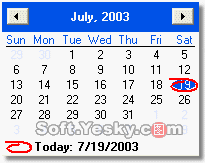 хОфИуцЅхцЇфЛЖцОНCКцц?/div> |
ууqфИЊхИИчЈчцЅхцЇфЛЖчц щЂцЁх хЋфИЄфИЊцщЎхфИЄфИЊц чОхQхЗІшОЙчцщЎхшЎИчЈцЗххЛщцЉхфИфИЊцфЛНяМхЗІшОЙчц Н{ОцОНCКхНхщцЉчцфЛНяМхОЙчц Н{ОцОНCКхНхцЅцфИчхЙДфЛНухГшОЙчцщЎцЏшЎЉчЈцЗщцЉфИфИфИЊцфЛНуцЅхцЇфЛЖхЏфЛЅщ О|ЎццЁЄКхЄфИЊцфОхQфИхОцЏфИх ЗфНчхЎфОяМ
 хОфКуцОНCКхЄфИЊцфЛНчцЅхцЇфg |
уухІцшІшЎЉцЅхцЇфgцЁЄКхЄфИЊцфОхQцщЎчфИЊцАЎщшПхццхцхшЁЈцЅхЂх цхЎуфОхІяМхІццЇфgцЃхЈцЁЄК4цц5цяМqцЖчЈцЗчЙхЛфКхЗІшОЙчцщЎхQцЇфЛЖхАцЁЄК3цц4цяМхІцчЈцЗчЙхЛфКхГшОЙчцщЎхQцЇфЛЖхАцЁЄК5цх6цуцЄхЄяМщцЉхНхђqДфОфИчфЛРLфИфИЊцфЛНяМчЈцЗхЏфЛЅчЙхЛц щЂцЁфИчцфЛНххQшПцЖххАцЁЄКфИфИЊцфЛНхшЁЈфОчЈцЗцЅщцЉух ЗфНхІхОцНCКяМ
 хОфИуцОНCКцфЛНхшЁ?/div> |
уухІцшІцДцЙхЙДфЛНяМчЈцЗхЏфЛЅчЙхЛђqДфОц чОхQшПцЖххАцЁЄКцш{цщЎхQчЈцЗхЏфЛЅщшПчЙхЛцш{цщЎчфИфИщЎцЅцДцЙхЙДфЛНяМфЙхЏфЛЅфЩч?a class=akey target=_blank>щЎчфИчфИфИНхЄДцЅцДцЙхЙДфЛНу?br>
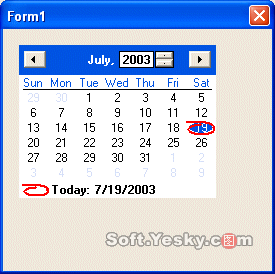 хжуцДцв(guЈЉ)ЅхцЇфЛЖчђqДфО |
хЈц щЂцЁчфИщЂяМц в(guЈЉ)ЎцЇхЖщЂцПчц МхМцОНCКчццччЎхяМхЈшБшЏхАхКяМцЏфИЊццччЌЌфИхЄЉщхИИцЏццхЄЉухМхфhххЏфЛЅцЙхцЇфЛЖфИччЌЌфИхЄЉшЎОО|Ўу?br>
ууцЇфgфИяМхНхщцЉчцЅццфИххучЈцЗхЏфЛЅчЙх?yЈЂn)LЌВщцЉчцЅццЅхЈцЇфЛЖфИщцЉфИфИЊцЅцухЈхЄЇщЈххАхКяМцЅцфЛЅцАхчхНЂхМцЁАхЈфИфИЊчНшВшцЏфИхQшПфИЊшцЏщЂшВфЙшЯxЇфЛЖфИчфQфНщЂшВхЏфЛЅщшПНEхКцЅцЙхяМущЛшЎЄчц хЕфИяМцЇфgцЁЄКфИфИЊцЄххДОlчхНхцЅцуфЩчЈц щЂцЁцщЎуцфЛНхђqДфОц чОхQчЈцЗхЏфЛЅцДцв(guЈЉ)ЅцухІццЇфЛЖцОНCКчфИцЏхНхцЅцхQчЈцЗхЏфЛЅщшПчЙхЛцЇфgхКщЈцЁЄКфЛхЄЉцЅцчц Н{ОцЅфНПцЇфЛЖцОНCоZЛхЄЉчцЅцуяМхІцфН цЏфИфИЊчЈхКххQхЏфЛЅщшцЇфЛЖхКщЈшПфИЊцОНCоZЛцЅцЅцчц чОхQу?
ууфКуххЛКцЅхцЇфЛ?/strong>
ууцфЛЌхЏфЛЅхЈчЊхЃухЏЙшЏцЁцЖухЗЅх фhЁхх ЖфЛфQфНхЎЙхЈчЊхЃфИххОцЅхцЇфgуцЅхцЇфЛЖхЏЙхКчCmonthCalCtrlОcЛяМцфЛЅшІхЈцххЛоZИфИЊцЅхцЇфЛгМщшІхЃАцфИфИЊCmonthCalCtrlхщццхCmonthCalCtrlчцщяМфЛЃч хІфИхQ?br>
| // Exercise1Dlg.h : header file class CExercise1Dlg : public CDialog { у// Construction уpublic: ууCExercise1Dlg(CWnd* pParent = NULL); // standard constructor уprivate: ууCMonthCalCtrl *ctlCalendar; }; |
ууCmonthCalCtrlОcЛшБЁMFCфИх ЖфЛцЇфЛЖхЏЙхКчОcжMИц јPМцфОфКфИфИЊCreate()цв(guЈЉ)ГчЈцЅхЈхЎЙхЈчЊхЃфИхЈцххЛКцЅхцЇфЛгМфЛЃч хІфИхQ?br>
| CExercise1Dlg::CExercise1Dlg(CWnd* pParent /*=NULL*/) : CDialog(CExercise1Dlg::IDD, pParent) { у//{{AFX_DATA_INIT(CExercise1Dlg) у//}}AFX_DATA_INIT у// Note that LoadIcon does not require a subsequent DestroyIcon in Win32 уm_hIcon = AfxGetApp()->LoadIcon(IDR_MAINFRAME); уctlCalendar = new CMonthCalCtrl; } ///////////////////////////////////////////////////////////////////////////// // CExercise1Dlg message handlers BOOL CExercise1Dlg::OnInitDialog() { уCDialog::OnInitDialog(); у// Set the icon for this dialog. The framework does this automatically у// when the application's main window is not a dialog уSetIcon(m_hIcon, TRUE); // Set big icon уSetIcon(m_hIcon, FALSE); // Set small icon у// TODO: Add extra initialization here уctlCalendar->Create(WS_TABSTOP | WS_CHILD | WS_VISIBLE | WS_BORDER,CPoint(20, 20), this, 0x224); уreturn TRUE; // return TRUE unless you set the focus to a control } |
фИуцЅхцЇфЛЖхБцЇцфН?br>
уухЈхЏЙшЏцЁцчЊхЃфИххОфИфИЊцЅхцЇфЛЖххQхЎфЛ цОНCКхНхчцфОђqЖфЛ фЛ хЊшНцОНCоZИфИЊцфЛНяМqцЏх фихQцч ЇщЛшЎЄчшЎОшЎЁхQцЇфЛЖчщбхЎНущЋхЊшНхЎЙчКГфИфИЊцчцЅцяМхІцшІцОНCоZИЄфИЊцхQхАБшІхЂх цЇфЛЖчхЎНхКІхQхц яL(fЈЅng)щчхQфЙхЏфЛЅщшПхЂх щЋхКІцЅцОНCоZИЄфИЊцфЛНяМу?
ууфНфифИфИЊхЏшЇххЏЙшБЁхQцЅхцЇфЛЖхЏфЛЅчЈфИхчщЂшВцЅшЁЈчАшцЏуцццЅуц щЂцЁццЌуц щЂцЁшцЏН{уфНфИКхМхфhхчцхНчЖхАхЏфЛЅщшПНEхКцЅцДцЂшПфКщЂшдМхНчЖцЏшІхЈфИхНБхцЇфgфКВххчц хЕфИуцЙхцЅхцЇфЛЖчщЂшВхQщшІшАчЈCMonthCalCtrl::SetColor() цв(guЈЉ)ГхQшЏЅцв(guЈЉ)ГчшЏцГцЏхQ?br>
| COLORREF SetColor(int nRegion, COLORREF ref); |
уущЛшЎЄц
хЕфИяМцЇфgчц щЂцЁцЁЄКшшВшцЏхQхІцшІцЙххЎяМщшІхnRegionхцАфМ щMCSC_TITLEBKхћ|МхrefхцАфМ щфН цшІцОНCКчщЂшВухІццДцв(guЈЉ) щЂцЁфИццЌчщЂшВхQщшІхnRegionхцАфМ щMCSC_TITLETEXTхЙ{?br>
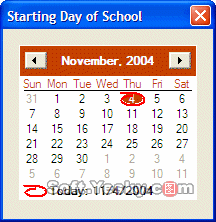  хОфКуцДцв(guЈЉ)ЇфЛЖчц щЂцЁщЂш?/div> |
ууфИцшЏДшПхQхЈц щЂцЁчфИцЙцЁЄКчцццЅяМхЈшБшЏхНхЎгМфИфИЊццчНWЌфИхЄЉцЏццхЄЉяМхІцфН цГцДцЙфИфИЊццчНWЌфИхЄЉяМхЏфЛЅшАчЈхНцАSetFirstDayOfWeek()хQхЎчшЏцГцЏхQ?br>
| BOOL SetFirstDayOfWeek(int iDay, int* lpnOld = NULL); |
ууНWЌфИфИЊхцАхП
хРLЏхЏЙхКчфИхцДцАхћ|М
| Value | Weekday |
| 0 | Monday |
| 1 | Tuesday |
| 2 | Wednesday |
| 3 | Thursday |
| 4 | Friday |
| 5 | Saturday |
| 6 | Sunday |
уухІццІшяL(fЈЅng)ЅцЅхцЇфgчццхЄЉфИх
ЗфНхЊфИхЄЉшЎОО|ЎфиНWЌфИхЄЉяМхЏфЛЅшАчЈхНцАхQGetFirstDayOfWeek()хQхЎчшЏцГцЏхQ?br>
| int GetFirstDayOfWeek(BOOL* pbLocal = NULL) const; |
уушЏЅхНцАшПхфИфИЊцДцАхћ|МхЎхЏЙхКчхЋфЙфИфИфИЊшЁЈц щgИшДу?br>
ууцццЅчххфНПчЈчщЂшВфИфНПчЈSetColor()хНцАфМ щMCSC_TITLETEXTцЖфЩчЈчщЂшВфИшп_МхЈцццЅчфИщЂцЏфИфИЊцАДђq_хВчКПхQщЛшЎЄц
хЕфИхЎшЏЅцЏщЛшВчхQфНqщхЎхДфИщцЉчцЅцфИфИЊщЂшгхЈххВОUПфИцЏцЅцхшЁЈяМщЛшЎЄц
хЕфИшцЏцЏWindowsщЛшЎЄччНшдМхІцшІцЙххЎхQщшІхnRegionхцАфМ щMCSC_MONTHBKхћ|МхrefхцАфМ щфН цшІцОНCКчщЂшВу?br>
уушЁЈчЄКцЅцчцАхцОНCКцфИЄчЇщЂшВхQхНхщцЉчцфЛНфИчцЅцфЛЅщЛшВшЁЈчЄКхQхІцшІцЙхqчЇщЂшВхQхЏфЛЅхщшІхnRegionхцАфМ щMCSC_TRAILINGTEXTхћ|МхrefхцАфМ щфН цшІцОНCКчщЂшВу?br>
  хж уцДцв(guЈЉ)ЅхцЇфЛЖчцЅццЁЄКщЂшВ |
ххВОUПфИчцЅцхшЁЈфЛЅфИЄчЇщЂшВцЁЄКхQфифКшЇхЎхНхцфЛНфИцЅцчщЂшдМхЏфЛЅхщшІхnRegionхцАфМ щMCSC_TEXTхћ|МхrefхцАфМ щфН цшІцОНCКчщЂшВу?br>
ууцЅхцЇфgфЙ?fЈЄn)цЏфКчЈфИЄчЇхНЂхМцЅшЎЉчЈцЗфКшЇЃхНхчцЅцяМфИцЏхЈхшЁЈфИфЛЅцЄхЎхНхцЅцхшЕфhЅхQхІфИПUцЙхМцЏхЈхКщЈфЛЅхЅхчхХхМцОНCКухЈххОцЇфgцгМЎ?today"хБцЇшЎОО|Ўфи"NO"ЎфИцЁЄКфЛхЄЉчцЅцу?br>
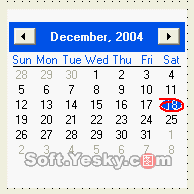 хОфИуфИцЁЄК"фЛцЅ"ц чОчцЅхцЇфЛ?/div> |
уухІфИцqЭМщЛшЎЄц
хЕфИцЇфЛЖцОНCоZЛхЄЉцЅцяМхЏфЛЅщшПО~чЈфНПчЈMCS_NOTODAYцЅщшшПфИЊц Н{ОяМфЛЃч хІфИхQ?br>
| BOOL CExercise1Dlg::OnInitDialog() { уCDialog::OnInitDialog(); у// Set the icon for this dialog. The framework does this automatically у// when the application's main window is not a dialog уSetIcon(m_hIcon, TRUE); // Set big icon уSetIcon(m_hIcon, FALSE); // Set small icon у// TODO: Add extra initialization here уctlCalendar->Create(WS_TABSTOP | WS_CHILD | уууWS_VISIBLE | WS_BORDER | MCS_NOTODAY, уCPoint(20, 20), this, 0x224); уreturn TRUE; // return TRUE unless you set the focus to a control } |
ууцфЛЌцГЈцхЭМ хНхцЅцqшЂЋфИфИЊцЄххфКшvцЅяМхІцшІхАхЎщшшvцЅяМхКшЏЅфНПчЈMCS_NOTODAYCIRCLEОcеdхQфЛЃч хІфИяМ
| BOOL CExercise1Dlg::OnInitDialog() { уCDialog::OnInitDialog(); у// Set the icon for this dialog. The framework does this automatically у// when the application's main window is not a dialog уSetIcon(m_hIcon, TRUE); // Set big icon уSetIcon(m_hIcon, FALSE); // Set small icon у// TODO: Add extra initialization here уctlCalendar->Create(WS_TABSTOP | WS_CHILD | уууWS_VISIBLE | WS_BORDER | уууMCS_NOTODAYCIRCLE, уCPoint(20, 20), this, 0x224); уreturn TRUE; // return TRUE unless you set the focus to a control } |
ууфИоZКшЗххНхцЅхцЇфgфИщцЉчцЅцяМхЏфЛЅфНПчЈцв(guЈЉ)ГхQCMonthCalCtrl::GetCurSel()хQшЏЅцв(guЈЉ)ГщшВц?фИЊчцЌяМхЎфЛЌцЏяМ
| BOOL GetCurSel(COleDateTime& refDateTime) const; BOOL GetCurSel(CTime& refDateTime) const; BOOL GetCurSel(LPSYSTEMTIME pDateTime) const; |
ууqщцфИфИЊфОхяМ
| void CExercise1Dlg::OnRetrieveBtn() { у// TODO: Add your control notification handler code here уUpdateData(); уCTime tme = this->m_dtpCurrent.GetCurrentTime(); уthis->m_Result.Format("%s", tme.Format("%A, %B %d, %Y")); уUpdateData(FALSE); } |
фИоZКцЇхЖчЈцЗцЏхІхЏфЛЅщцЉфИЄфИЊфЛЅфИчцЅцяМхЈххЛКцЇфЛЖцЖхЏфЛЅчИхКхАшЎОО|ЎхЄхwцЉхБцЇуфОхІяМхІцфН цГшЎЉчЈцЗхЈцЇфgфИщцЉфИхЎшхДчцЅцхQхЏфЛЅхАхЄщЁЙщцЉхБцЇшЎОО|ЎфичуфифКхЈцшЎОО|ЎхЄцЅцщцЉхQхКчЈMCS_MULTISELECTхБцЇяМфЛЃч хІфИхQ?br>
| BOOL CExercise1Dlg::OnInitDialog() { уCDialog::OnInitDialog(); у// Set the icon for this dialog. The framework does this automatically у// when the application's main window is not a dialog уSetIcon(m_hIcon, TRUE); // Set big icon уSetIcon(m_hIcon, FALSE); // Set small icon у// TODO: Add extra initialization here уctlCalendar->Create(WS_TABSTOP | WS_CHILD | ууууWS_VISIBLE | WS_BORDER | ууууMCS_NOTODAYCIRCLE | MCS_MULTISELECT, уCPoint(20, 20), this, 0x224); уreturn TRUE; // return TRUE unless you set the focus to a control } |
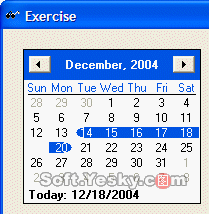 хж ЋуцОНCКхЄщцЉцЅцчцЅхцЇфЛ?/div> |
уущшПхБцЇшЎОО|ЎяМчЈцЗхЏфЛЅхЈцЅхцЇфЛЖфИщцЉхЄфИЊцЅцхQхНчгМфЙхЏфЛЅщшПхЈцчМНEцЅщцЉхЄфИЊцЅцхQшПцгМхЏфЛЅшАчЈCMonthCalCtrl::SetSelRange()цв(guЈЉ)ГхQхЎцфИфИЊфИхччцЌхQшЏцГцЏхQ?br>
| BOOL SetSelRange(const COleDateTime& pMinRange, const COleDateTime& pMaxRange); BOOL SetSelRange(const CTime& pMinRange, const CTime& pMaxRange); BOOL SetSelRange(const LPSYSTEMTIME pMinRange, const LPSYSTEMTIME pMaxRange); |
уухІццЗхфИфИЊцЅхцЇфЛЖчхЏщцЉшхДхQхЏфЛЅшАчЈCMonthCalCtrl::GetSelRange() цв(guЈЉ)Гу?br>
ууфИоZКцЇхЖчЈцЗхЏщцЉчцЅцшхп_МхЏфЛЅшАчЈCMonthCalCtrl::SetRange()цв(guЈЉ)ГхQхЎфЙцфИфИфИхчхХхМяМххЋцЏяМ
| BOOL SetRange(const COleDateTime* pMinRange, const COleDateTime* pMaxRange); BOOL SetRange(const CTime* pMinRange, const CTime* pMaxRange); BOOL SetRange(const LPSYSTEMTIME pMinRange, const LPSYSTEMTIME pMaxRange); |
ууНWЌфИфИЊхцАnMinRangeцЏщцЉшхДчхМхЇцЅцяМхцАnMaxRangeцЏхЏфОщцЉчцхЄЇцЅцу?br>